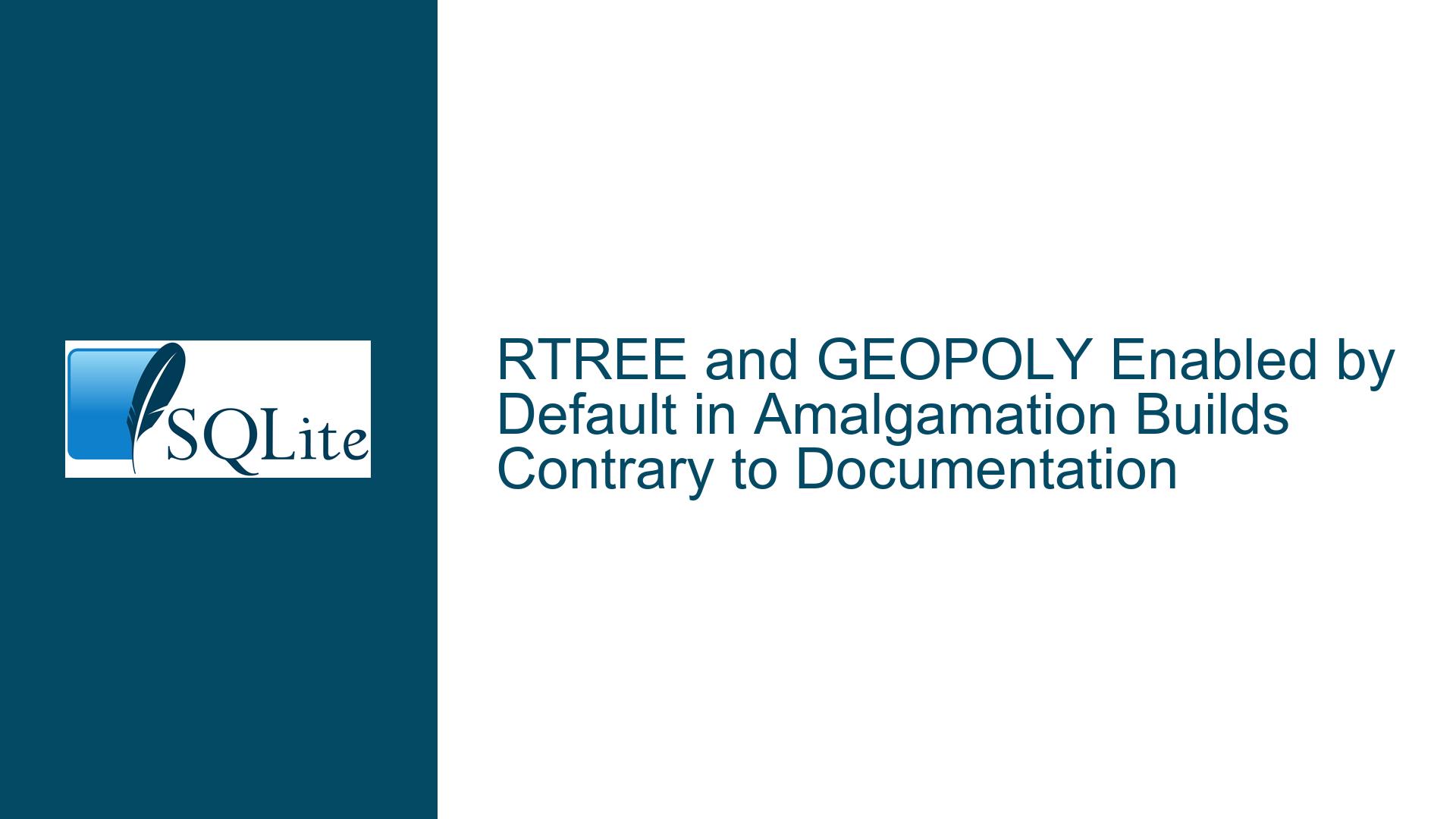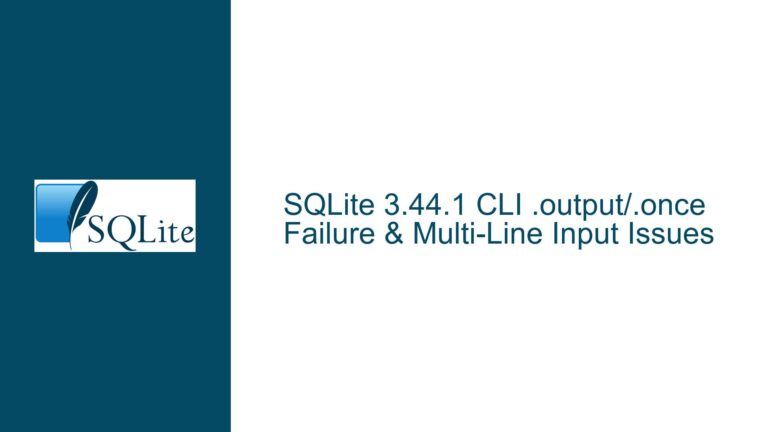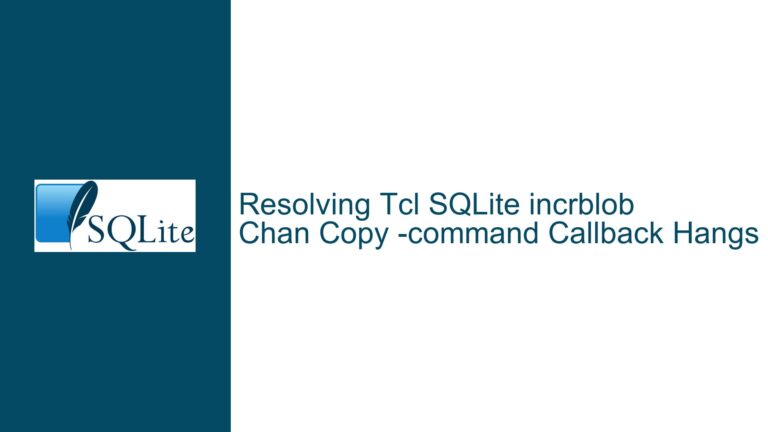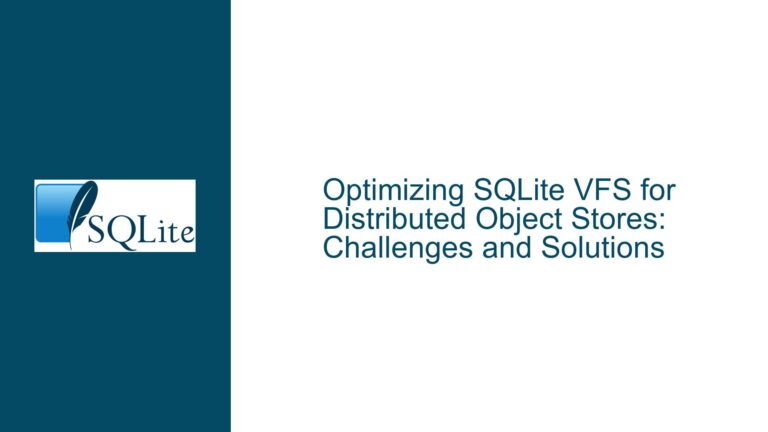RTREE and GEOPOLY Enabled by Default in Amalgamation Builds Contrary to Documentation
Discrepancy Between SQLite Documentation and Default Configuration Flags for RTREE, GEOPOLY, and Math Functions
Issue Overview
The core issue revolves around inconsistencies between SQLite’s official documentation and the default configuration flags applied during compilation of the SQLite amalgamation. Specifically, the documentation for the RTREE, GEOPOLY, and math functions (e.g., log2) states that these features are either disabled by default or require explicit compile-time flags to enable. However, users compiling SQLite via the sqlite-autoconf package (a pre-packaged amalgamation) observe that these features are enabled by default, leading to confusion and potential compatibility issues.
The RTREE module (used for spatial indexing) and GEOPOLY extension (for geospatial polygon operations) are documented as requiring the -DSQLITE_ENABLE_RTREE and -DSQLITE_ENABLE_GEOPOLY flags, respectively, to be included in the build. Similarly, math functions like log2 are tied to the -DSQLITE_ENABLE_MATH_FUNCTIONS flag. The documentation implies these features are opt-in, but the configure script bundled with the sqlite-autoconf tarball enables them by default. This creates a mismatch between expected and actual behavior, particularly for developers relying on the documentation to build SQLite with specific feature sets.
A secondary issue involves outdated instructions for compiling the SQLite shell. The "How to Compile SQLite" guide previously omitted the -DSQLITE_ENABLE_MATH_FUNCTIONS flag in its example command, causing errors when using math functions like log2 in applications. While this specific oversight was addressed in a recent documentation update, the broader problem of documentation inaccuracies persists for other features.
Root Causes of Configuration and Documentation Mismatches
Amalgamation vs. Source Tree Builds:
SQLite provides two primary build methods: the amalgamation (a singlesqlite3.cfile) and the source tree (individual source files). Thesqlite-autoconftarball is a pre-generated amalgamation distributed with Autoconf scripts for easier integration into Unix-like systems. Critically, the amalgamation’sconfigurescript enables certain features by default (e.g., RTREE, GEOPOLY, FTS5) to simplify deployment. However, the documentation describes the source tree build process, where these features are disabled by default unless explicitly enabled. This distinction is not clearly articulated in the documentation, leading users to misinterpret the defaults for their chosen build method.Evolving Defaults Without Documentation Updates:
SQLite’s build configuration defaults have shifted over time to prioritize usability. For example, FTS5 (Full-Text Search v5) was initially disabled in source tree builds but enabled in amalgamation builds. The amalgamation’sconfigurescript now enables RTREE, GEOPOLY, and math functions by default to cater to common use cases. However, the documentation has not kept pace with these changes, creating a false impression that these features require manual activation.Ambiguity in Compile-Time Flag Documentation:
The documentation for RTREE and GEOPOLY explicitly states that these modules are included in the amalgamation but "disabled by default." This phrasing is misleading because the amalgamation’sconfigurescript automatically adds the necessary flags (-DSQLITE_ENABLE_RTREE,-DSQLITE_ENABLE_GEOPOLY) unless explicitly overridden. Users compiling the amalgamation without Autoconf (e.g., embedding SQLite directly into a project) might still need to enable these flags manually, but those using the providedconfigurescript do not. This nuance is absent from the documentation.Incomplete Example Commands in Guides:
The "How to Compile SQLite" page historically provided example commands that excluded flags like-DSQLITE_ENABLE_MATH_FUNCTIONS, leading to runtime errors when applications relied on math functions. While this was rectified, similar omissions in other guides risk perpetuating the problem.
Resolving Configuration Conflicts and Updating Build Practices
Step 1: Clarify Build Method Differences in Documentation
Update the RTREE, GEOPOLY, and FTS5 documentation to explicitly distinguish between source tree and amalgamation builds. For example:
The RTREE module is included in the amalgamation but disabled by default when building from the source tree. The
sqlite-autoconfamalgamation enables RTREE by default via itsconfigurescript. To disable it, pass--disable-rtreetoconfigure.Add a dedicated section to the "How to Compile SQLite" guide explaining the divergence in default flags between build methods. Highlight that the amalgamation’s
configurescript enables features like RTREE, GEOPOLY, FTS5, and math functions by default for convenience, whereas source tree builds require manual flag activation.
Step 2: Audit and Synchronize Compile-Time Flags
For users of the
sqlite-autoconfamalgamation:- Review the
config.logfile generated duringconfigureexecution to verify enabled features. Search for-DSQLITE_ENABLE_RTREE,-DSQLITE_ENABLE_GEOPOLY, and-DSQLITE_ENABLE_MATH_FUNCTIONSin theBUILD_CFLAGSvariable. - To override defaults, pass
--disable-rtree,--disable-geopoly, or--disable-math-functionsto theconfigurescript. For example:./configure --disable-rtree --disable-geopoly
- Review the
For users embedding the amalgamation (
sqlite3.c) directly into projects:- Explicitly define required flags during compilation. For example, to disable RTREE and GEOPOLY:
gcc -DSQLITE_ENABLE_FTS5 -DSQLITE_ENABLE_MATH_FUNCTIONS -c sqlite3.c
- Explicitly define required flags during compilation. For example, to disable RTREE and GEOPOLY:
Step 3: Validate Feature Availability in the SQLite Shell
After compiling SQLite, confirm which features are enabled:
- Launch the SQLite shell:
sqlite3 - Execute:
.pragma compile_options; - Check the output for
ENABLE_RTREE,ENABLE_GEOPOLY, andENABLE_MATH_FUNCTIONS. If present, the features are active.
Step 4: Adjust Application Code for Feature Compatibility
If RTREE, GEOPOLY, or math functions are enabled unintentionally:
- Modify SQL queries to avoid dependencies on these features. For example, replace
log2(x)with a custom implementation if math functions are unstable. - For spatial applications, conditionally use RTREE/GEOPOLY only if detected at runtime:
SELECT CASE WHEN rtree_check() = 'ok' THEN spatial_query() ELSE fallback_query() END;
Step 5: Contribute to Documentation Updates
- Report discrepancies via SQLite’s forum or GitHub mirror. Reference specific documentation pages and build configurations.
- Propose rewrites for ambiguous sections. For instance, the GEOPOLY documentation should state:
The Geopoly extension is included in the amalgamation and enabled by default when using the
sqlite-autoconfconfigure script. To disable it, compile with-DSQLITE_OMIT_GEOPOLYor pass--disable-geopolytoconfigure.
Step 6: Customize Builds for Minimalist Environments
For resource-constrained environments where unused features bloat the binary:
- Download the amalgamation source (
sqlite3.candsqlite3.h). - Compile with flags to disable defaults:
gcc -DSQLITE_OMIT_RTREE -DSQLITE_OMIT_GEOPOLY -DSQLITE_OMIT_MATH_FUNCTIONS -c sqlite3.c - Link the optimized binary into the project.
Step 7: Monitor SQLite’s Release Notes and Changelogs
SQLite’s defaults and configuration flags occasionally change between releases. Before upgrading, review the changelog for entries like:
2023-03-12: The amalgamation configure script now enables GEOPOLY by default. Add –disable-geopoly to retain prior behavior.
Adjust build scripts accordingly to maintain compatibility.
By systematically addressing documentation ambiguities, validating build configurations, and tailoring compilation flags, developers can align their SQLite deployments with project requirements. Proactive engagement with SQLite’s update cycle further ensures long-term stability when leveraging modules like RTREE, GEOPOLY, and math functions.






